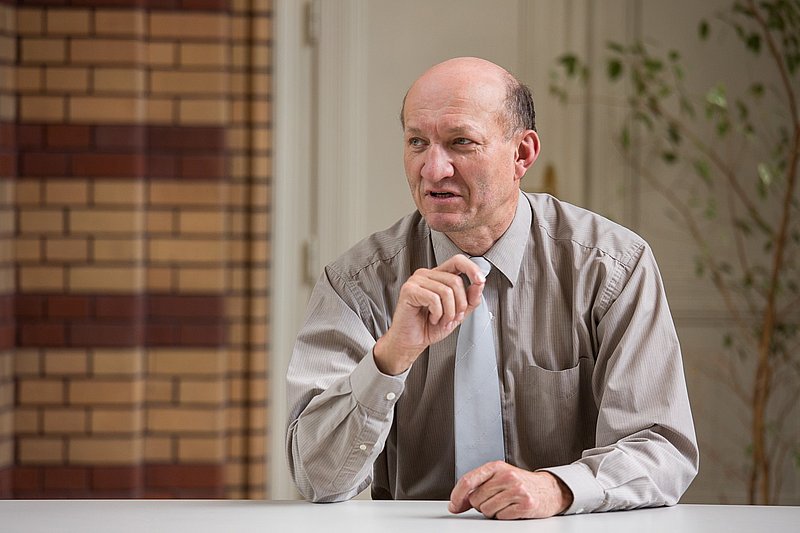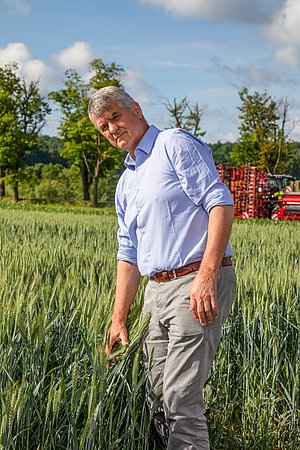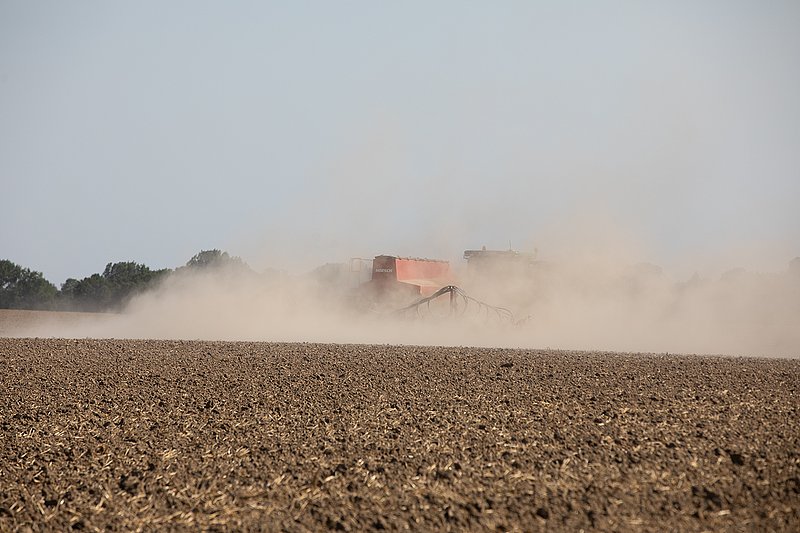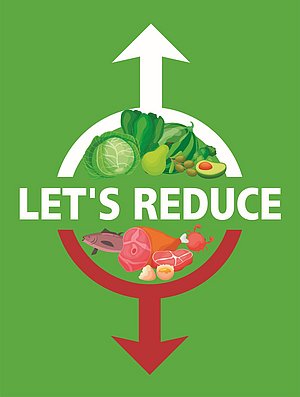Climate and supply situation
Corona bottlenecks and conflicts drive up the prices for food. In the past years, weather extremes have increased and intense heat, floods etc affect farming. But what is changing? How does the climate influence our yields? And what would have to change to avoid a situation where the supply with staple foods is reduced extremely? terraHORSCH discussed this topic with Michael Horsch and Frank Wechsung.

terraHORSCH: Mister Wechsung, you have been working at the Potsdam Institute for Climate Impact Research (PIK) since its foundation. What is your opinion about the climate changes of the past years?
Frank Wechsung: When we deal with climate change and climate impact, we actually often have long-term changes in mind that occur on average. This is what we understand by climate – beyond the weather. It is about the long-term, stable trends and they are accompanied by fluctuations which also manifest in to extremes. We also were surprised by what happened in the past four years. We did not expect three drought years in a row for Germany. So it is a rather special problem as probably there are phenomena hiding behind it which can be deduced from the climate models only with a lot of imagination. The concrete events in Central Europe were extremely surprising – with regard to the characteristics as well as to the actual appearance. But we now have to deal with it.
What is giving us a hard time in the first instance is not this average physical phenomenon but the change of the circulation of the atmosphere. As the temperature gradients are shifting, e.g. between the polar regions and the central regions or the central regions and the tropics, the circulation systems are changing. West wind weather situations which normally very reliably bring rain to our regions, suddenly circulate differently. If there is a stable high above Germany, they are pushed towards the north for quite some time. This is intensified because the temperature gradient diminishes between the Arctic and the subtropics. This attenuation of the temperature gradient and of other gradients, also between land and water, might lead to an increased development of the persistence of weather situations. At least this is the explanation we have so far. It is what causes our problems and what might also be relevant for other regions in the world.

terraHORSCH: Mister Horsch, as a manufacturer of agricultural machinery, do you also increasingly notice problems among the farmers caused by climatic changes?
Michael Horsch: Yes, I do. I travel a lot in the arable farming regions of this world, among others in Brazil, the US, Eastern Europe, Australia etc. The farmers often tell me that they can no longer achieve the yields as they did before. They talk about intense heat, long droughts or heavy rainfalls that again and again drag down and affect the yields. I have been in the business for more than thirty years and for the past ten years I have been noticing these events to an increasing extent. We also more and more often experience this on our own farms in Europe. There are frequent dry or cold periods, heavy rainfall, heat or it is cloudy for a longer period of time – as it was the case last year in June and July. Because of the cloudy weather, there was no photosynthesis. We first thought that we would achieve top yields as there was enough rain throughout Europe but finally the harvest was below average. The war in the Ukraine only intensifies the problem of a worldwide shortage of cereals, but it is not the only reason. There are also the resistances caused by plant protection agents that prevent the yields from increasing. Only for maize and soya there has been breeding progress.
My subjective explanation is: the climate changes are not only a fact but from the point of view of staple food shortage they also advance faster than predicted. There have been heat waves and droughts before. But the accumulations succeed one another faster and also are more extreme. I am no weather expert. But this is what I have noticed on the fields all over the world during the past ten years.
terraHORSCH: Can you confirm this, Mister Wechsung? Do these extreme weather situations increase faster than imagined?
Frank Wechsung: At the PIK, several colleagues are dealing with these cumulative extremes. The increasing persistence of weather situations I have already mentioned plays a special role. In 2010, there was an extreme heat wave in Russia. The high-pressure area remained there for a very long time and prevented rainfall areas from approaching. The result were massive wildfires caused by heat and drought. In Pakistan, however, it did not stop raining and there were floods. A low-pressure area remained on site. One can assume that there is a trend for an increasing persistence of weather situations in some regions of the world, ours being among them. This does not mean that the weather will become drier or wetter but that if there is a high-pressure situation somewhere it will remain there for a very long time. We have seen this during the past three years. And the same is true for low-pressure situations. The flood in the valley of the Ahr, too, was predicted by this weather pattern. The whole month was characterised by an approaching flow from the southwest which again and again brought rain to this region. Mr Horsch’s stories about the problems of the farmers also seem to reflect this. So far, it does not seem – and let‘s hope that it stays this way – that the pendulum swings in the one or in the other direction and that these three dry years announced that there will be a change towards a drier climate in Germany. But we probably have to reckon with an increasing persistence of wet and dry weather situations.
terraHORSCH: Will it become more difficult to feed the world population because of these extreme weather phenomena?
Frank Wechsung: The crucial point probably are not only the extremes alone, but their persistence, i.e. the fact that we will have to struggle with drought for several years. The Australians are quite experienced with handling long dry periods respectively with the alternation of dry and rain periods. In this respect, we can learn from them. The yield increase rate depends on the weather and the climate. I think the result of the climate fluctuation, the climate change can be that in certain regions, especially if they become drier, the yield will decrease or stagnate. We will have to deal with this to an increasing extent.
Michael Horsch: 70% of our daily calorie requirement is covered only by cereals and oilseeds. Directly as we eat rice, wheat, bread, indirectly as we use it to feed our productive animals. This is what we have to be aware of. We have to change our eating habits and for example reduce the share of animal products in our food. Many of us think they could simply do a little bit of urban farming and eat more fruits and vegetables. But this will not solve the problem, especially in the third world. People there depend on cereals. If corn prices double or triple because of shortages etc., we have a problem! We depend on cereal crops to cover most of people’s energy requirement. Cereals can only be grown on fields, with a lot of sun for photosynthesis, enough water and mild temperature. If there is no balance, it will impair the amount of energy we produce.
When I meet farmers, we often discuss. A lot of them say that their yields stagnate or decrease. The breeding industry has already reacted with illness and heat resistant varieties. However, the yields at best remain on the same level. Another dilemma is that we only have about 1 billion ha of arable land worldwide which decreases every year. And a more intensive use of the land as we saw it in the past 20 years (e.g. in Russia or the Ukraine) as by now the farms are run on a high level. We also contributed to this fact. In other words: There simply are no more cereals to be expected like it has always been the case for example in the past 100 years when breeding, technology, the Haber-Bosch method, plant protection and training always more than compensated for the increasing demand for food.
The increasing ecologisation, too, risks to reduce the yield even further. With regard to the climate changes and our environment, health and society we, of course, need a more ecological agriculture but only on one premise: We have to maintain the yields. This is the reason why we have been pushing the idea of hybrid farming for years.
So far, our agricultural policy believed that it did justice to the people. In my opinion, the politicians now are forced to face reality and to see to it that we do not only protect the environment but also have to feed the world. Because of the changes of the climate, the pandemic and now the war in the Ukraine it cannot be excluded that we are right in the middle of a shortage of staple food. In my opinion, this is what the signs indicate.
Frank Wechsung: Well, I think that this problem was never gone. We simply cherished the illusion – especially in the past thirty years – that we did no longer have to practice a planned storage like we did before. I would not talk about a new crisis, we simply have to return to a realistic assessment of the political and climatic possibilities and guarantee a corresponding agricultural production at home.

terraHORSCH: Is it possible to refill the grain stores and to straighten out the situation?
Michael Horsch: I think that under the current circumstances it will be difficult to refill the supplies. Unless the climate means us well and there will be two years of plenty what cannot be excluded completely!?
Frank Wechsung: It is possible. But we have to set our heart on it. And it is important to fix a goal. And the incentive schemes have to make the efforts pay off.
Moreover, the politicians have got used to that fact that the agricultural sector has no problems to lay the table. At the beginning of the 90s, we had harvest supplies for 365 days in our stores all over the world. Within the scope of a – say – strong orientation of the agricultural sector on efficiency criteria this was reduced and the analogue storage in warehouses was replaced by a provision by means of financial instruments. This only works as long as everyone plays along. As soon as somewhere there is a problem with the supply situation, the first thing a country does is to impose an export ban or to introduce export taxes. This is why the EU as a large agricultural area, but Germany too, has to keep a certain degree of self-supply as a target criterion in mind. And it has to be safeguarded independent of any trends and booms. During the Covid 19 crisis this was discussed at length. We suddenly realized that we actually cannot simply outsource everything as in this case we are no longer able to compensate for shortfalls in supply at short notice. All these discussions always took place against the background that we are dealing with a freely available sector. But this is not the case. There are frame conditions that have to be taken into account. Even if food prices were comparatively low in the past twenty, thirty years, the slightest disturbance may cause the whole system to explode. We are currently witnessing it.
Let’s take the latest example: the three largest actors on the wheat market, Ukraine, Russia and India are still active in the agricultural market despite the crop failure in India and the war between Russia and the Ukraine and they export what they have to spare. And if they do not deliver, we will import from other countries. This is the idealised vision of the macroeconomists. But in reality, it does not work like this – at least not in a year’s time.

terraHORSCH: What would have to change to secure the future and the food?
Michael Horsch: It is not so much about the fact that we won’t have anything to eat in the future, but we have to discuss what we are going to eat in the future. And we as the affluent world have to change our eating habits. I.e. the share of animal products in our food has to be reduced and the share of vegetable products has to increase. You now can, of course, discuss, by how many per cent. If this happens automatically now because the prices are going through the roof and the farmers will get 400, 500 Euros for one tonne of wheat and the price for a chicken or a pig will not simply be one Euro per kilo but two, three Euros, this might be the best way to solve this problem rather quickly. However, you have to remain alert. For if the crop price remains high, the people in the third world will have enormous problems to feed themselves. We absolutely have to see to it that we guarantee their supply and continue to support them so that these countries can expand their own food production.